by Lisa Cooke | Feb 6, 2017 | 01 What's New, DNA |
Sometimes history provides us with a situation that is just too outlandish to be false, like this one on mDNA testing for genealogy by using ancient ponytails! In these lucky, true-to-life conditions, clues to help us unravel genealogical mysteries and tell our own crazy stories might just be found.
![By GrammarFascist (Own work) [CC BY-SA 4.0 (http://creativecommons.org/licenses/by-sa/4.0)], via Wikimedia Commons mDNA testing on ancient ponytails](https://lisalouisecooke.com/wp-content/uploads/2017/01/Dreadlocks_attribution-needed.jpg)
English Mutineers Create Endogamous Population
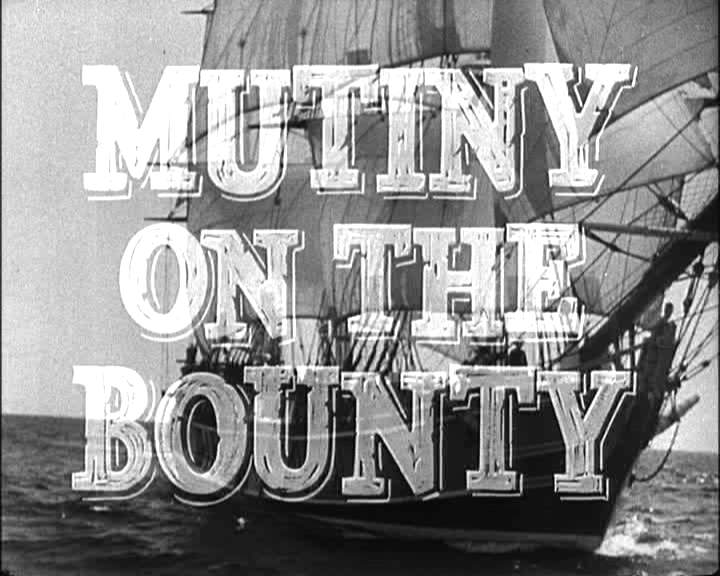
By Trailer screenshot (Mutiny on the Bounty trailer) [Public domain], via Wikimedia Commons
And when I say tiny, I mean tiny. 1.75 square miles tiny.
But considering that 9 English mutineers, their Tahitian brides, and a couple Tahitian men were the founding population for this island, it provides an amazing genetic and genealogical view into endogamous populations.
The Proof is in the Pigtails
This fascinating tale is about to get richer, as ten pigtails of hair claiming to be from some of the original mutineers and their wives, have recently been acquired by the Pacific Union College’s (PUC) Pitcairn Islands Study Center in California. The King’s College London has contracted them to perform DNA testing.
Pay close attention to this next part: Researchers are going to conduct DNA testing on the hair samples. But this does not mean you are going to be able to test the locks of hair stowed away from one of your ancestors!
Why, you ask?
First barrier: Cost. This process of trying to extract DNA from a hair sample, especially a very, very old hair sample is meticulous work. It will cost the average consumer a pretty penny. And, you may not be able to find a DNA testing company who wants to do it for you. All major genetic genealogy companies will just flat out tell you “no.” Most paternity testing companies will require your hair has the root attached. In fact, in my quick search, I can’t even find one DNA testing company that will attempt to get DNA from your lock of hair.
Second barrier: Results. Even if you could get a lab to extract the DNA for you, the only available DNA type retrieved from a cut piece of hair is mitochondrial DNA (mtDNA). The mtDNA will trace a direct maternal line. This is opposed to the YDNA that traces a direct paternal line and the autosomal DNA which traces both sides of your family tree. Even if they do get mtDNA from your sample, it is likely to be damaged and incomplete. Therefore, the best you will likely get is an assessment of your deep ancestral origins.
For you, that might not be quite enough to determine and document your family history. But for those interested in verifying this story of mutineers settling in the Pitcairn islands, it might be.
Will it Work?
If they do get mtDNA from the 10 pigtails, they will get 10 mtDNA lineages represented. Those stemming from the mutineers should have their deep origins in Europe, while their Tahitian brides will have a very different mtDNA signature. Likewise, if an mtDNA signature can be obtained, then the mtDNA of those still living in Pitcairn and nearby Norfolk (where many went in 1857) should match these pigtails. If it does, they can measure how many of the current residents are directly maternally related. Of course, in order to truly verify the claims, some serious genealogy work must be completed.
I will be watching this story closely over the next few months as research progresses. If successful, this will be another victory for the rarely celebrated mtDNA. This study shows that if your goals are understanding deep heritage, or testing out a particular hypothesis on your maternal line, mtDNA can be a useful option.
While the DNA studies you read about in the paper won’t always be something you can learn from, others are. Take for example the stories I shared several months ago on the Genealogy Gems podcast and blog about DNA confirming the love affair of President Warren G. Harding and the story of how experts proved it was King Richard III buried under that parking lot. You can definitely learn about using DNA for genealogy from these very public examples!
More on mDNA Testing for Genealogy
When to Do an mDNA Test for Genealogy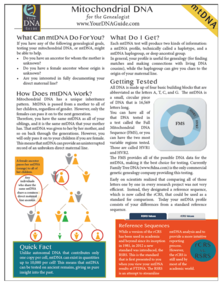
mDNA Quick Guide for Genealogists by Diahan Southard
by Lisa Cooke | Oct 18, 2015 | 01 What's New, Conferences
The Texas State Genealogical Society 2015 Family History conference kicks off in less than 2 weeks. I’ll be there! Can you come? Here’s a discount code just for Gems  fans!
fans!
My home state of Texas does EVERYTHING in a big way. So it’s no surprise the upcoming Texas genealogy conference will pack so much into their 2-day event, October 31 – November 1. Here’s a run-down of the weekend AND my friends-and-family discount code that you can use to save on registration.
2 KEYNOTE SPEAKERS. I’m looking forward to sharing the keynote stage with J. Mark Lowe, an expert genealogist and a very skilled and fun teacher. I think we’ll all have a lot of fun during these presentations.
GET-IT-DONE WORKSHOPS. Come and learn super practical skills to move your family history research ahead! I’m teaching “Learn How to Time Travel with Google Earth” and “How to Use Evernote for Genealogy” (Levels 1 and 2). Mark will teach a workshop on Genealogical Research in the South and another called “Following a Case through Court.”
43 CLASSES IN 14 TRACKS. Beginners are welcome–and intermediate/advanced researchers will have plenty to chew on–during 2 days of breakout sessions with topics that include: Genealogy for Beginners, DNA, African-American Research, Courthouse Records & Records Loss, Adoption, Hispanic Research, Methodology, Libraries & Repositories, Historical Context, Societies & Communities, and Digital Genealogy.
Early-bird registration has officially ended, but I have coupon code that passes on my friends-and-family discount to YOU. Use coupon code family20 to get $20 off the $150 fee for the full 3-day registration or coupon code family10 to get $10 off any single-day registrations. Click here to register now.
P.S. You can share this code with YOUR friends and family! Please do, in fact! Thank you!
Click below to read more about attending genealogy conferences:
The Benefits of Attending Genealogy Conferences: Podcast interview with Dick Eastman. Listen for free!
Where Should You Sit at a Genealogy Conference?
by Lisa Cooke | Oct 22, 2015 | 01 What's New, Evernote, FamilySearch, Listeners & Readers, Source Citation
Here’s how can you add family history documents you’ve grabbed with the Evernote web clipper to your tree on FamilySearch!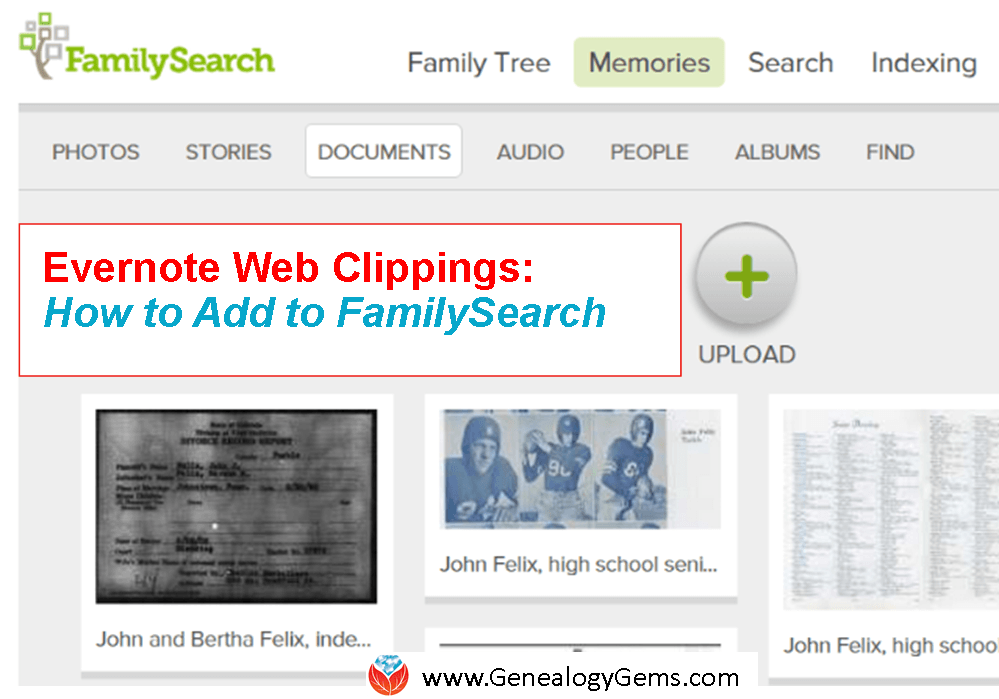
Recently Zooey wrote in with this question: “I’ve clipped numerous things for my ancestors [with the Evernote web clipper] that I want to put in FamilySearch. How do I do it under Documents?”
Good for Zooey for having her genealogy sources organized in Evernote–and for wanting to cite her sources on her FamilySearch family tree. Here’s how to do it:
FamilySearch Documents support the following file types: .pdf, .jpg, .tif, .bmp, and .png. Since it doesn’t currently have an “import from Evernote” feature, you’ll need to export the web clippings from Evernote and then upload them to FamilySearch.
Earlier this year I wrote an article on our blog entitled “Here’s a Cool Way to Export a Web Clipping from Evernote.” The article will walk you through exporting your Evernote web clippings as pdf files, which FamilySearch Documents can then accept as uploads.
More Evernote for Genealogy Tips on the Genealogy Gems Website:
You can find all our past articles on using Evernote for genealogy (including the one I mentioned) at the home page of our website. On the left, just under the main red menu, you will see a drop down menu called “Select Content by Topic.” Click the down arrow and select “Evernote” from the list. This will display all our past Evernote articles on your screen starting with the most recent. Or get started with these great how-tos:
How to Use Evernote for Genealogy: The Ultimate Education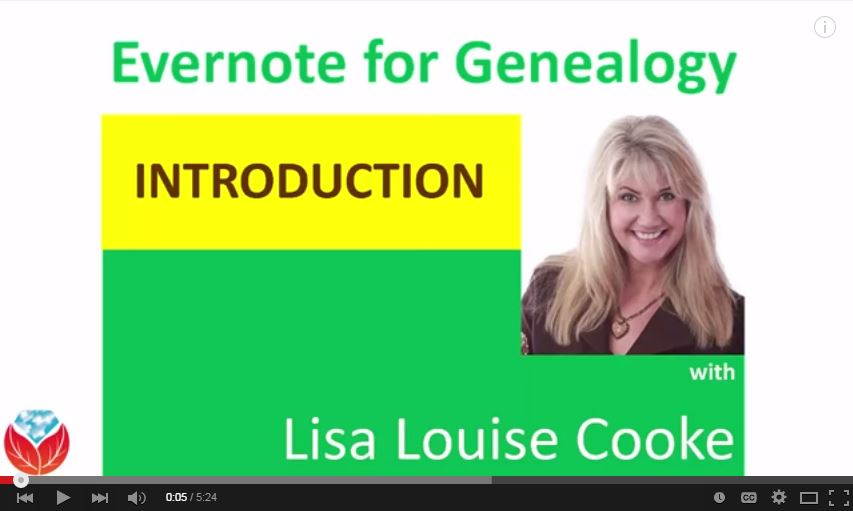
Evernote for Genealogy: What It Is, and Why You Would Use It (FREE VIDEO!)
How to Use Evernote for Genealogy and Family History: Handwriting, OCR, Video and Upload Answers (FREE VIDEO!)
 Thank you for sharing this post with others. We would all love our online trees to be better sourced–and for others’ trees to be better sourced, too.
Thank you for sharing this post with others. We would all love our online trees to be better sourced–and for others’ trees to be better sourced, too.
by Lisa Cooke | Apr 26, 2017 | 01 What's New, Book Club
Beloved American novelist Fannie Flagg is our newest Genealogy Gems Book Club author! Nobody can spin a story quite like she can, as she proves in The Whole Town’s Talking. You’ll love the stories of her funny, foibled characters in this intergenerational saga of a small, fictional town in the American Midwest.
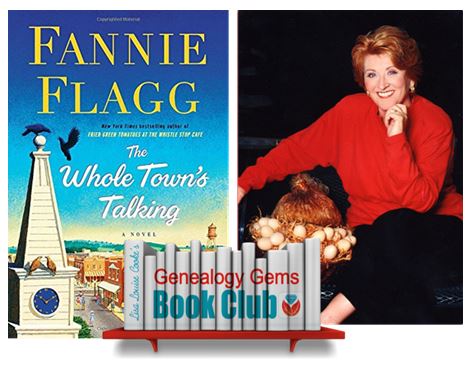
 The Whole Town’s Talking is best-selling author Fannie Flagg’s newest novel. A Swedish immigrant plants roots in the American Midwest and advertises in Swedish-American newspapers for a bride and neighbors to settle the land. Thus begins the town of Elmwood Springs, Missouri, the setting of several of Fannie’s previous novels.
The Whole Town’s Talking is best-selling author Fannie Flagg’s newest novel. A Swedish immigrant plants roots in the American Midwest and advertises in Swedish-American newspapers for a bride and neighbors to settle the land. Thus begins the town of Elmwood Springs, Missouri, the setting of several of Fannie’s previous novels.
Over several decades, descendants of the original settlers populate the town. As residents die, they appear again among their neighborly dead in the local cemetery. They continue to gossip and chatter and, occasionally, suffer. (One poor man finds himself buried between his first wife and his second, who didn’t get along in life and still don’t.)
Much-loved characters from other Fannie Flagg novels appear in The Whole Town’s Talking (or at least their ancestors do). Swedish immigrant Lordor Nordstrom is an ancestor of young Dena Nordstrom from Welcome to the World, Baby Girl! Among his neighbors are the fascinating families of spunky Elner Shimfissle, her nervous niece Norma and Poor Tot from Can’t Wait to Get to Heaven. We even hear echoes of Neighbor Dorothy, the famous housewife with the radio show in Standing in the Rainbow.
In The Whole Town’s Talking, Fannie Flagg captures the broad sweep of Midwestern history while staying grounded in the stories of everyday people. It’s easy to fall in love with the folks from Elmwood Springs, to cheer them on in their struggles and successes, to match-make their children, to laugh along with them (and sometimes at them, bless their hearts). Their foibles and quirks likely will remind you of many on your family tree. That’s all the better, given Fannie’s premise that these folks continue to live on and take an interest in our lives. To a genealogist who falls more in love with her ancestors the more she knows buy medication online forum about them, I find this a pretty irresistible notion.
Special thanks to Genealogy Gems Premium member Richard in Sacramento CA, who recommended The Whole Town’s Talking! He loved “the time span, the family relations and the discussions as folks entered the cemetery and the town changed.”
There’s more of Fannie Flagg to love….
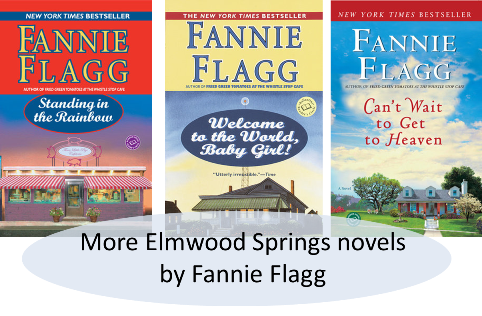 In fact, Richard has read all of Fannie Flagg’s books. He thinks several of them would be “valuable reads” for the Genealogy Gems Book Club.” I agree wholeheartedly! I’m a longtime Fannie Flagg fan, ever since I saw the movie version of her classic novel Fried Green Tomatoes at the Whistle Stop Cafe.
In fact, Richard has read all of Fannie Flagg’s books. He thinks several of them would be “valuable reads” for the Genealogy Gems Book Club.” I agree wholeheartedly! I’m a longtime Fannie Flagg fan, ever since I saw the movie version of her classic novel Fried Green Tomatoes at the Whistle Stop Cafe.
When you finish The Whole Town’s Talking, consider picking up one of the other Elmwood Springs stories already mentioned: Welcome to the World, Baby Girl! or Can’t Wait to Get to Heaven or Standing in the Rainbow.
 I can’t resist recommending Fannie’s second most-recent novel, too: The All-Girl Filling Station’s Last Reunion. The main character is Sookie, a lovable Southern woman (she is Dena Nordstrom’s best friend in Welcome to the World, Baby Girl!) Sookie discovers she is not who she thinks she is. After a huge family secret is revealed, she questions everything she has ever believed about herself and her family. Sookie launches a secret search for a new sense of identity under the nose of her loving but domineering mother. She navigates the effects of her discoveries on her sense of identity, her marriage and her daughters’ lives. It’s funny, it’s poignant–and along the way she learns about a fascinating and little-known chapter in American history.
I can’t resist recommending Fannie’s second most-recent novel, too: The All-Girl Filling Station’s Last Reunion. The main character is Sookie, a lovable Southern woman (she is Dena Nordstrom’s best friend in Welcome to the World, Baby Girl!) Sookie discovers she is not who she thinks she is. After a huge family secret is revealed, she questions everything she has ever believed about herself and her family. Sookie launches a secret search for a new sense of identity under the nose of her loving but domineering mother. She navigates the effects of her discoveries on her sense of identity, her marriage and her daughters’ lives. It’s funny, it’s poignant–and along the way she learns about a fascinating and little-known chapter in American history.
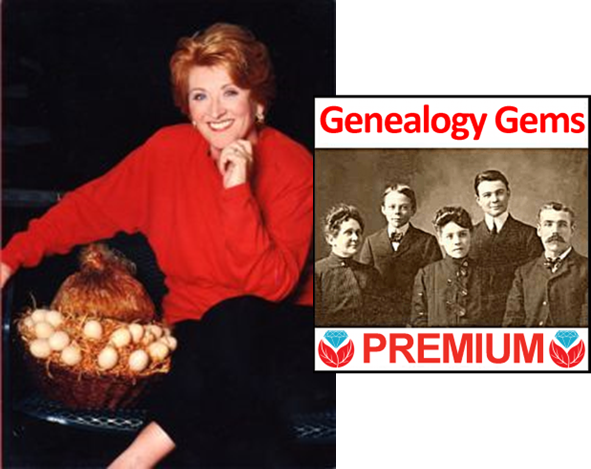 I hope you enjoy Miss Fannie Flagg as much as Richard and I do! The immortal storyteller herself will join us on the Genealogy Gems Premium Podcast in two months. So go read The Whole Town’s Talking! (And if you’re not a Genealogy Gems Premium website member, consider becoming one. A teaser clip from our conversation will appear in the free Genealogy Gems Podcast episode #204, but to hear the whole thing, you’ll need access to the Genealogy Gems Premium Podcast episode #148.
I hope you enjoy Miss Fannie Flagg as much as Richard and I do! The immortal storyteller herself will join us on the Genealogy Gems Premium Podcast in two months. So go read The Whole Town’s Talking! (And if you’re not a Genealogy Gems Premium website member, consider becoming one. A teaser clip from our conversation will appear in the free Genealogy Gems Podcast episode #204, but to hear the whole thing, you’ll need access to the Genealogy Gems Premium Podcast episode #148.
![By GrammarFascist (Own work) [CC BY-SA 4.0 (http://creativecommons.org/licenses/by-sa/4.0)], via Wikimedia Commons mDNA testing on ancient ponytails](https://lisalouisecooke.com/wp-content/uploads/2017/01/Dreadlocks_attribution-needed.jpg)



 fans!
fans!


 Thank you for sharing this post with others. We would all love our online trees to be better sourced–and for others’ trees to be better sourced, too.
Thank you for sharing this post with others. We would all love our online trees to be better sourced–and for others’ trees to be better sourced, too.

 In fact, Richard has read all of Fannie Flagg’s books. He thinks several of them would be “valuable reads” for the Genealogy Gems Book Club.” I agree wholeheartedly! I’m a longtime Fannie Flagg fan, ever since I saw the movie version of her classic novel
In fact, Richard has read all of Fannie Flagg’s books. He thinks several of them would be “valuable reads” for the Genealogy Gems Book Club.” I agree wholeheartedly! I’m a longtime Fannie Flagg fan, ever since I saw the movie version of her classic novel 
 I hope you enjoy Miss Fannie Flagg as much as Richard and I do! The immortal storyteller herself will join us on the Genealogy Gems Premium Podcast in two months. So go read
I hope you enjoy Miss Fannie Flagg as much as Richard and I do! The immortal storyteller herself will join us on the Genealogy Gems Premium Podcast in two months. So go read